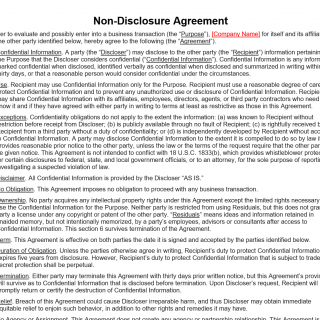Non-Disclosure Agreement (NDA)
A Non-Disclosure Agreement (NDA) is a legal document that is used to protect confidential information that is shared between two or more parties. The NDA establishes a confidential relationship between the parties and outlines the terms and conditions for protecting the confidential information.
The NDA typically consists of several parts, including an introduction, a definition section, a description of the confidential information, the obligations of the parties, the term of the agreement, and any other relevant provisions. The introduction typically includes the names of the parties and the purpose of the agreement. The definition section defines key terms used in the agreement, such as "confidential information" and "disclosure." The description of confidential information outlines the specific information that is covered by the agreement. The obligations of the parties section outlines the duties and responsibilities of each party, such as how the confidential information can be used and how it should be protected. The term of the agreement section specifies how long the agreement will be in effect.
The most important fields in the NDA are typically the definition of confidential information and the obligations of the parties. These sections define the scope of the agreement and the responsibilities of each party.
The NDA is compiled in cases where confidential information is shared between parties who want to protect that information. The parties involved in the document are typically the party disclosing the confidential information (the disclosing party) and the party receiving the confidential information (the receiving party).
When compiling an NDA, it is important to consider the specific information that needs to be protected and the obligations of each party. The agreement should be clear and specific in defining the confidential information and the responsibilities of each party.
The advantages of an NDA include protecting confidential information from being shared or used without permission, establishing a confidential relationship between parties, and providing a legal remedy for any breaches of the agreement.
The potential problems when filling out an NDA can include vague or unclear language, defining confidential information too broadly or too narrowly, or failing to specify the obligations of each party clearly.
Related forms to an NDA may include a Confidentiality Agreement, a Trade Secret Agreement, or a Proprietary Information Agreement. Alternative forms may include a Mutual Non-Disclosure Agreement, which establishes a confidential relationship between two parties sharing confidential information.
The NDA can be submitted to the appropriate parties through email, fax, or mail. It is recommended to store the instances of the NDA in a secure location, such as a password-protected folder or a safe, to ensure that the confidential information is protected.

